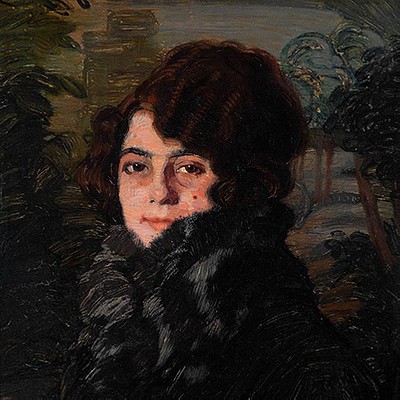ANTONIO REYNA (Coín, Málaga, 1859 - Rome, 1937). "Greek girl with pan flute". Oil on panel.
Lot 51
About Seller
Setdart Auction House
Carrer Aragó 346
Barcelona
Spain
Setdart Subastas was born in 2004 and is currently the first online art auction in Spain with solidity, prestige and reliability guaranteed by our more than 60,000 users. Setdart has a young, dynamic and enterprising team ready to successfully manage the purchase and sale of art works through custom...Read more
Estimate:
EUR€5,000 - EUR€6,000
$5,376.34 - $6,451.61
Absentee vs Live bid
Two ways to bid:
- Leave a max absentee bid and the platform will bid on your behalf up to your maximum bid during the live auction.
- Bid live during the auction and your bids will be submitted real-time to the auctioneer.
Bid Increments
| Price | Bid Increment |
|---|---|
| EUR€0 | EUR€10 |
| EUR€200 | EUR€25 |
| EUR€500 | EUR€50 |
| EUR€1,000 | EUR€100 |
| EUR€3,000 | EUR€200 |
| EUR€5,000 | EUR€500 |
| EUR€10,000 | EUR€1,000 |
| EUR€20,000 | EUR€2,000 |
| EUR€50,000 | EUR€5,000 |
About Auction
By Setdart Auction House
Jul 15, 2021
Set Reminder
2021-07-15 08:00:00
2021-07-15 08:00:00
America/New_York
Bidsquare
Bidsquare : 19th & 20th CENTURY PAINTINGS & ORIENTALISM
https://www.bidsquare.com/auctions/setdart-auction-house/19th-20th-century-paintings-orientalism-7212
Setdart Auction House sofia@setdart.com
Setdart Auction House sofia@setdart.com
- Lot Description
ANTONIO REYNA (Coín, Málaga, 1859 - Rome, 1937). "Greek girl with pan flute". Oil on panel. It has a period frame. Signed and located in Rome in the lower right corner. Measures: 46 x 22 cm; 70 x 45 cm (frame). Through a fast and material stroke, the artist presents a child's portrait. With a completely modern technique, the author transports the viewer to classical antiquity, not only by the use of a symmetrical and clear composition, but also by the presence of elements related to classical culture. An example of this is the sarcophagus where the girl is seated, the pan flute, and even the goat, which could allude to the fauns. Who participated in the Bacchic cults playing the pan flute. Nowadays considered one of the most relevant Andalusian landscape painters of the 19th century, Antonio Reyna began his training at the School of Fine Arts in Malaga, where his teachers were Joaquin Martinez de la Vega and Bernardo Ferrándiz. From a very young age he exhibited his works regularly, standing out in the local artistic environment for his colorful, attractive compositions and the ease of his brushstroke. His progress would be spectacular, and in 1882 he obtained a pension from the Diputación de Málaga to further his studies in Italy. Reyna had fallen in love with Rome, and in that city he would live forever. In Rome, like so many other Spaniards, he frequented Villegas, and in his orbit he worked on oriental and "casacón" themes, the latter of exquisite workmanship and refined chromatic variety. At the same time, as one more member of the Spanish colony, he participated in the gatherings at the Café Greco. Although his habitual residence seems to have always been in the Eternal City, he soon traveled to Venice, from where in 1885 he sent a view of the Grand Canal, and in 1887 there were many "vedute" paintings of that city. In fact, won over by their beauty and picturesqueness, he devoted himself to the realization, in small formats, of such urban landscapes, repeating them on many occasions with minimal variations. Venice is at that time a pole of attraction for Spaniards thanks to Fortuny's widow and the weight of Villegas's Venetian production, adding also the effect of the summer stays (with later continued residence) of Martín Rico, whose precious landscape painting is transmitted to Reyna. In 1887, a missing canvas of large proportions, entitled "Floralia", gave him a third class medal at the National Exhibition of Fine Arts, being considered at the time as the painter's best painting. In 1910, on the occasion of his mother's death, Reyna spent some time in his hometown. There he was inspired to create another of his most celebrated successes, the canvas "Rancho Andaluz", which he showed at the International Exhibition of Fine Arts in Rome the following year. Some years before, in 1895, the queen regent Maria Cristina had granted him the cross of knight of the order of Carlos III, associating the fact to the realization of some over doors that later passed to the Ateneo of Madrid, although apparently they are not now in that whereabouts. Reyna also exported his work to London, especially his Venetian views. He also held regular exhibitions in Rome, showing among other works two portraits of Pope Benedict XV, which demonstrate his expertise in this genre. In his painting, certainly novel for the time, the painter shows at all times his skill in drawing, as well as an innate ability for composition, marked by the boldness of his brushstrokes and a great chromatic richness. On December 5, 2009, on the occasion of the 150th anniversary of Antonio Reyna's birth, a large anthological exhibition of his work was inaugurated at the García Agüera Foundation in Malaga. Currently, Antonio Reyna has a museum with his name in Coín, and is also represented in the Diputación de Málaga, the Fine Arts Museums of Málaga and Boston.
- Shipping Info
-
In-house shipping available. Please inquire at admin@setdart.com.
-
- Buyer's Premium



 EUR
EUR CAD
CAD AUD
AUD GBP
GBP MXN
MXN HKD
HKD CNY
CNY MYR
MYR SEK
SEK SGD
SGD CHF
CHF THB
THB

















